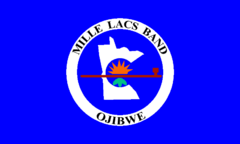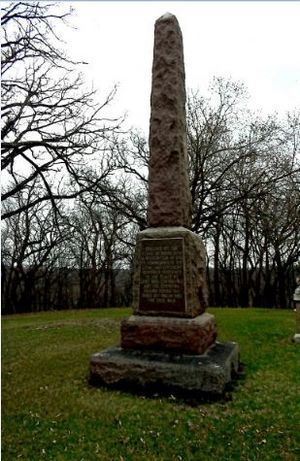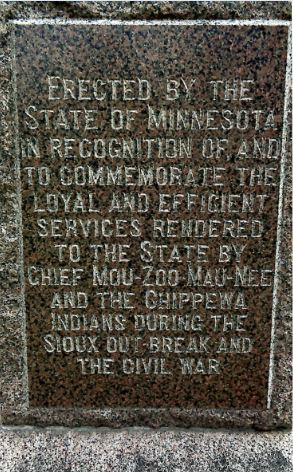Mille Lacs Band of Ojibwe facts for kids

tribal flag
|
|
| Total population | |
|---|---|
| 4,302 | |
| Regions with significant populations | |
| Languages | |
| English, Ojibwe | |
| Related ethnic groups | |
| White Earth Band, Leech Lake Band, Grand Portage Band, Bois Forte Band, Fond du Lac Band |
The Mille Lacs Band of Ojibwe (which in their language, Ojibwe, is called Misi-zaaga'igani Anishinaabeg) is also known as the Mille Lacs Band of Chippewa Indians. This group is a recognized American Indian tribe. They live in east-central Minnesota. In 2012, the Band had 4,302 members. Their homeland is the Mille Lacs Indian Reservation. This reservation includes different areas called District I, District II, District IIa, and District III.
The Mille Lacs Band is one of six groups that form the Minnesota Chippewa Tribe. They helped create this larger tribe in 1934. The other groups are the White Earth Band, Leech Lake Band, Grand Portage Band, Bois Forte Band, and Fond du Lac Band. The word "Chippewa" is often used in the United States to talk about Ojibwe people. However, the Mille Lacs Band prefers the name "Ojibwe," which is also more common in Canada.
Contents
Understanding Ojibwe Clans
Among the Mille Lacs Band of Ojibwe, there are eight main doodem or clan types. A clan is like a family group that shares a common ancestor or symbol. These clans are named after animals and represent different roles and responsibilities within the community.
- Bizhiw (Lynx)
- Makwa (Bear)
- Waabizheshi (Marten)
- Awaazisii (Bullhead)
- Ma'iingan (Wolf)
- Migizi (Bald Eagle)
- Name (Sturgeon)
- Moozens (Little Moose)
Historically, some members of the Mille Lacs Band had connections to the Mdewakanton Dakota people. Also, the Snake River Band of Isanti Dakota joined with the St. Croix Band of Lake Superior Chippewa. Because of these family ties, many members of the Mille Lacs Band of Ojibwe belong to the Ma'iingan-doodem (Wolf clan).
History of the Mille Lacs Ojibwe
The Ojibwe people, who speak a language from the Algonquian family, first came together on the Atlantic coast of North America. About 500 years ago, the ancestors of the Mille Lacs Band of Ojibwe started moving west. This long journey is part of their oral traditions, which are stories passed down through generations. Scientists and historians have found evidence that supports these stories.
By the mid-1700s, the Ojibwe had settled around Mille Lacs Lake in what is now East Central Minnesota. They had moved into this area after the Dakota villagers who lived there before. The Ojibwe had a rich and varied diet. They hunted animals like deer, bear, moose, and waterfowl. They also fished in the lakes and streams. They gathered important foods like wild rice, maple sugar, nuts, and berries. They also grew some plants.
Later, Europeans like French, British, and American fur traders began to arrive. Some of these new settlers stayed and started to compete with the Mille Lacs Band for resources. They also began to move onto the Band's land. Over many years, these settlers often broke the agreements and treaties that the Mille Lacs Band made with the United States and British leaders.
The Ojibwe people also faced new challenges, including diseases brought by the Europeans. These illnesses caused many deaths. By the end of the 1800s, only a few hundred Ojibwe remained on the Mille Lacs Indian Reservation. At this time, the United States government tried to force the Ojibwe to change their way of life. They stopped the Ojibwe from practicing their traditional religion. Many Ojibwe had also become Catholic, but they still blended it with their traditional prayers. The government also sent Ojibwe children to boarding schools, where they were made to learn and speak only English. The Ojibwe's right to govern themselves was almost taken away. It became very hard for them to follow their traditional way of life.
During the Dakota War of 1862, also known as the Sioux hostilities, Chief Hole in the Day threatened to join the war. However, Chief Mou-zoo-mau-nee of the Mille Lacs Band sent 300 warriors to Fort Ripley to help defend it. Because of their help, the Mille Lacs Band signed two treaties in 1863 and 1864. These treaties recognized their actions and made sure the tribe could not be removed from their reservation. The reservation's borders were also made permanent. In 1914, the State of Minnesota put up a large monument at Fort Ridgely cemetery to honor Chief Mou-zoo-mau-nee and the Mille Lacs Band for their service.
For the next 100 years, the Ojibwe bands in the Mille Lacs region faced poverty and hardship. In 1934, the Indian Reorganization Act was passed. This law helped Native American tribes reorganize their governments. The bands in the Mille Lacs region joined five other bands to form the Minnesota Chippewa Tribe between 1934 and 1936. The four historical bands in the Mille Lacs region (Mille Lacs Indians, Sandy Lake Band, Rice Lake Band, and Snake and Kettle River Bands) were reorganized into the Mille Lacs Band of Ojibwe.
In the early 1990s, the Band opened two casinos: Grand Casino Mille Lacs and Grand Casino Hinckley. The money earned from these casinos has greatly helped the Mille Lacs Band. It has allowed them to strengthen their culture, become financially independent again, rebuild their reservation, and improve the lives of people in the entire region.
How the Mille Lacs Band Governs Itself
The Mille Lacs Band has a government with three separate parts, much like the government of the United States. This is called a separation-of-powers system. It means that different groups have different jobs, and they work together to make sure the government runs fairly.
Executive Branch: Leading the Band
The Chief Executive is the main leader of the Mille Lacs Band of Ojibwe. Currently, this leader is Melanie Benjamin.
Band members vote for the Chief Executive every four years. The Chief Executive is in charge of the executive branch. This branch carries out the laws and manages the daily work of the government. The Chief Executive chooses people called commissioners to lead different departments. The Band Assembly must approve these choices.
Some of the important departments in the executive branch include:
- Department of Justice: This department handles legal matters and public safety. It includes the Tribal Police Department, which helps keep the community safe.
- Administration Department: This department manages many services, like career development, support for adults and youth, human resources, and keeping community buildings in good shape.
- Department of Community Development: This group works on housing, building projects, and public services like roads, water, and sanitation.
- Corporate Commission: This department oversees the Band's businesses, like the casinos and other investments.
- Department of Health and Human Services: This department provides healthcare services through clinics and offers support for families and mental health.
- Department of Natural Resources: This group takes care of the land, water, and animals. They manage things like community gardens, wild rice, forests, and fisheries. They also work to protect the environment.
- Department of Education: This department runs schools like Nay Ah Shing School and other education programs for children and young adults. They also manage the library.
Legislative Branch: Making the Laws
The legislative branch is called the Band Assembly. This group makes the laws for the Band. It has one Representative from each of the reservation's three districts. There is also a Secretary/Treasurer who leads the Band Assembly as its Speaker.
Each Representative is chosen by the people in their district and serves for four years. Band members who live outside the reservation choose a home district to vote in. The Secretary/Treasurer is elected by all Band members.
The current Secretary/Treasurer and Speaker of the Band Assembly is Sheldon Boyd, who was elected in April 2018.
The Band Assembly also oversees the Office of Budget and Management, which handles the Band's money, including payroll and insurance.
Judicial Branch: Upholding Justice
The judicial branch is responsible for making sure laws are followed fairly. The Chief Justice of the Mille Lacs Band of Ojibwe is Rayna Mattinas.
This branch includes the Chief Justice and the Court of Central Jurisdiction. This court has three appellate justices (who review decisions from lower courts) and one district judge (who hears cases first).
- Tribal Court: This is where legal cases are heard within the Band's own justice system.
Independent Agencies: Special Roles
There are also some independent agencies that have specific jobs:
- Department of Athletic Regulation: This group might oversee sports or athletic events.
- Gaming Regulatory Authority (GRA): This agency makes sure that the casinos and other gaming activities follow all the rules and are fair.
Businesses of the Mille Lacs Band
The Mille Lacs Band owns and operates several businesses, which help support the community and create jobs. These businesses are part of their "Corporate Ventures Holdings."
- Gaming:
* Grand Casino Hinckley in Hinckley, Minnesota * Grand Casino Mille Lacs in Vineland, Minnesota
- Hospitality: The Band owns several hotels, including:
* DoubleTree by Hilton Downtown Saint Paul in St. Paul, Minnesota * DoubleTree by Hilton Minneapolis Park Place in St. Louis Park, Minnesota * Embassy Suites Will Rogers Airport Hotel in Oklahoma City, Oklahoma * InterContinental Saint Paul Riverfront in St. Paul, Minnesota
- Marketing & Technology:
* Foxtrot Marketing Group, which includes Sweetgrass Media. * Maadaadizi Investments. * Makwa Global, LLC, a company with offices in several locations, including Minneapolis, Minnesota, and even internationally.
- Wewinabi, Inc. (Local Businesses): This includes a variety of local businesses that serve the community:
* Big Sandy Lodge & Resort in Libby, Minnesota * Convenience stores like Crossroads Convenience Store and East Lake Convenience Store. * Grand Makwa Cinema (a movie theater) and Grand Market (a grocery store). * Mille Lacs Super Stop, which includes a Taco John’s restaurant. * Woodlands National Bank, with several branches in Minnesota.
Leaders of the Mille Lacs Band
Here is a list of some of the important leaders who have served the Mille Lacs Band of Ojibwe.
Chairmen
- 1936–1940: Fred Sam
- 1940–1948: Sam Yankee
- 1948–1956: Fred Jones
- 1956–1960: Jerry Martin
- 1960–1972: Sam Yankee
- 1972–1991: Arthur Gahbow
- 1991–1992: Marge Anderson (served temporarily)
Chief Executives
- 1992–2000: Marge Anderson
- 2000–2008: Melanie Benjamin
- 2008–2009: Herbert Weyaus (served temporarily)
- 2009–2012: Marge Anderson
- 2012–present: Melanie Benjamin
Notable Members of the Band
Many people from the Mille Lacs Band of Ojibwe have achieved great things and are well-known.
- Marge Anderson
- James Clark, also known as Naawigiizis
- Lucy Clark
- Marvin Eagle
- Arthur Gahbow / Wewinabi
- Virgil Hill, a famous boxer
- Maude Kegg / Naawakamigookwe
- Larry Smallwood / Amikogaabaw
- Sam Yankee / Eshpan
|



